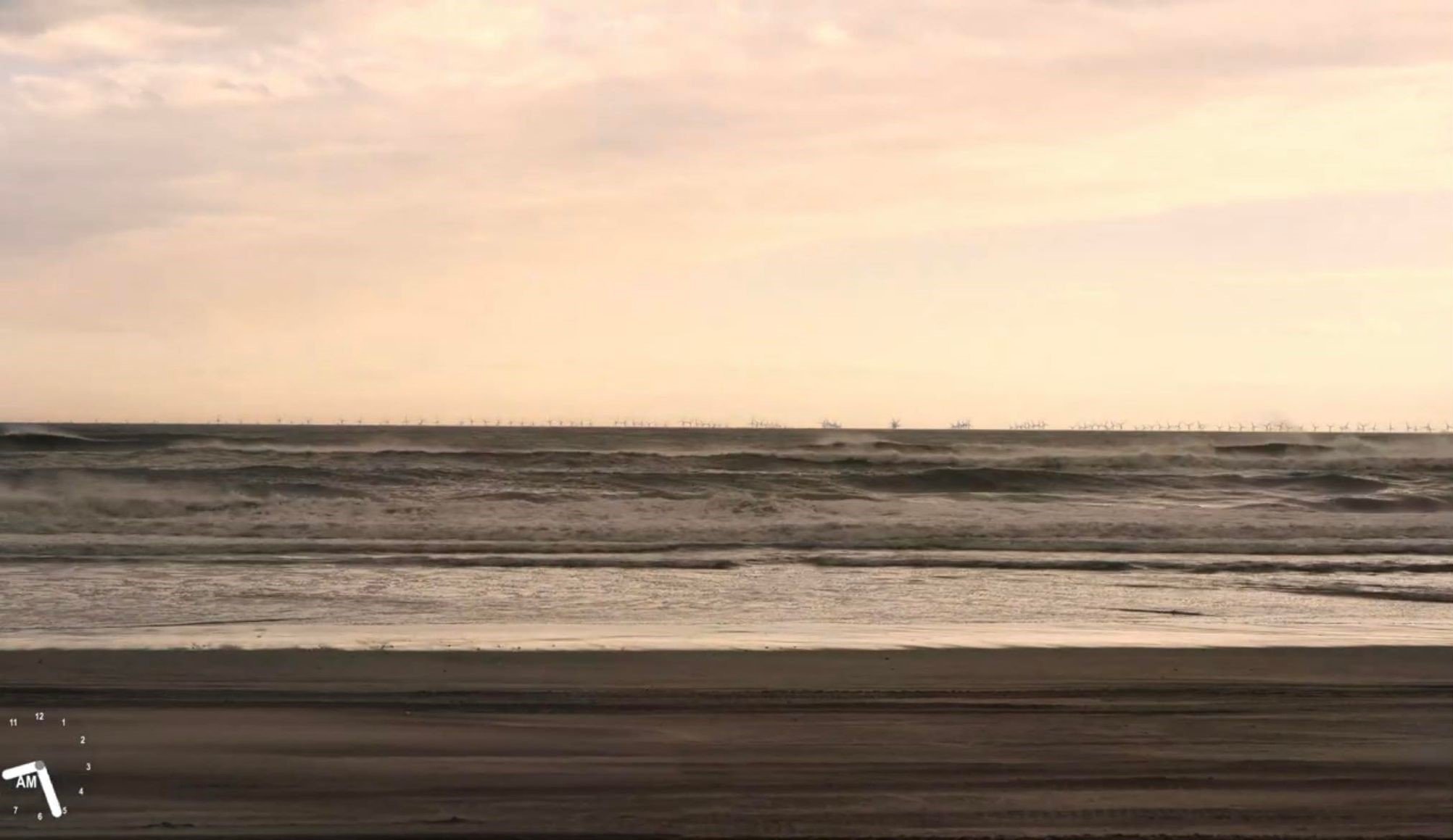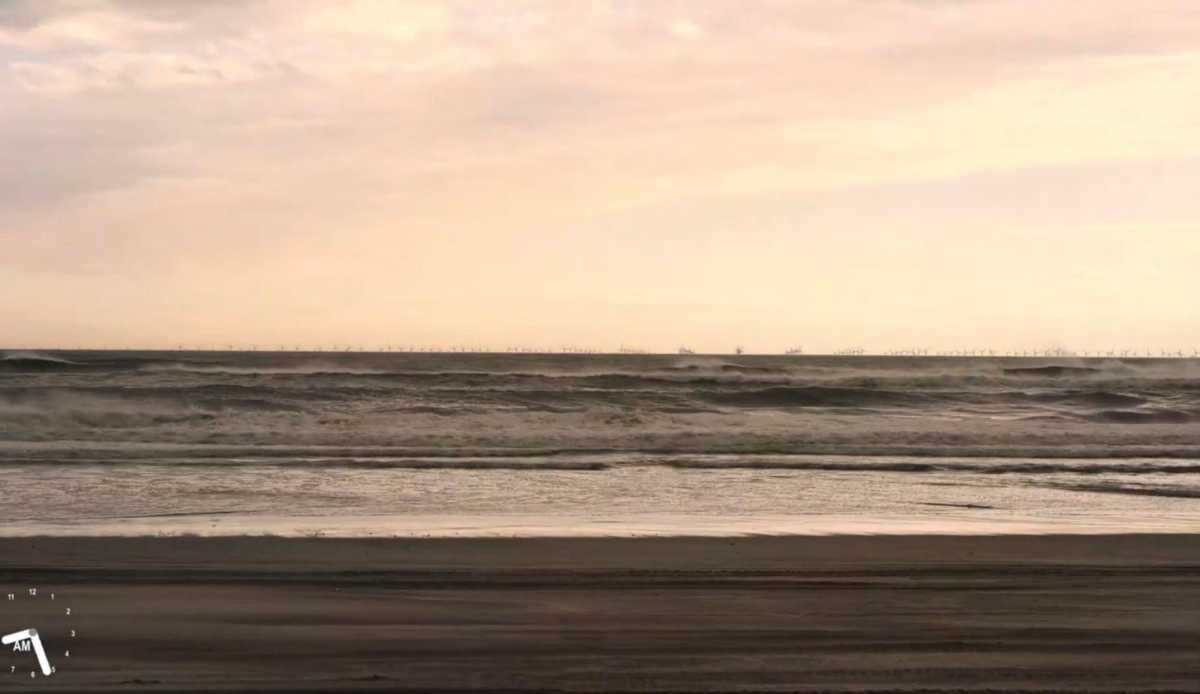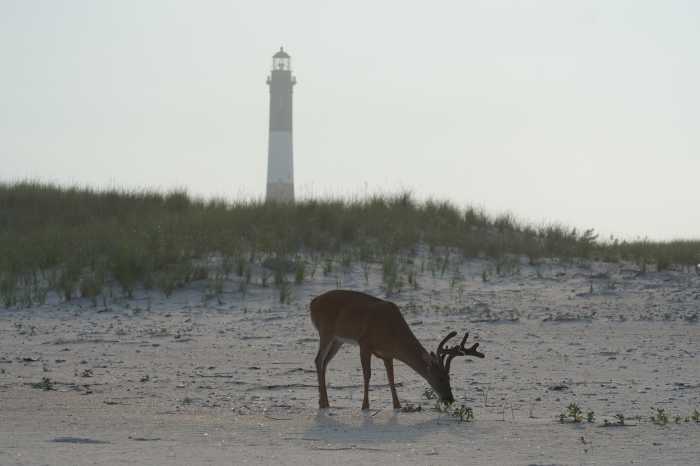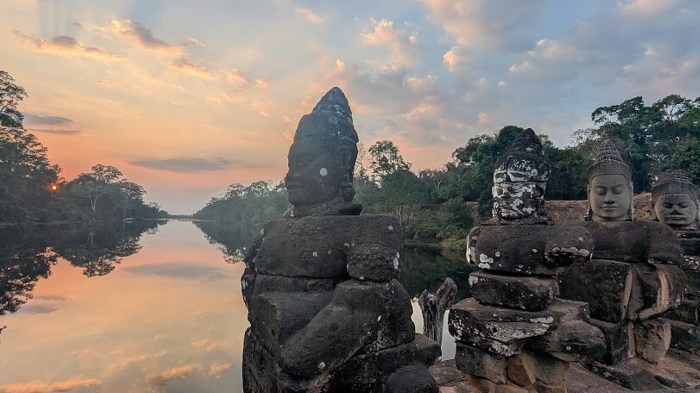
A screenshot from a visual simulation video depicting what the Empire Wind project will look like from the eastern portion of Lighthouse Beach on Fire Island during clear atmospheric conditions. (Video was created by Equinor/ Bureau of Ocean Energy Management YouTube channel)
By Skylar Epstein
Offshore wind energy projects are beginning to appear on the literal and metaphoric horizons of Long Island. Fire Island residents have a right to wonder what these energy projects mean for the future of our island and its surrounding oceanic ecosystem. It is time to cut through the misinformation and explore the nuances of how offshore wind will impact our beloved island.
What Wind Projects Are in Development?
The most relevant offshore wind projects to Fire Island are the Empire Wind and Sunrise Wind projects, both of which are still awaiting their Final Environmental Impact Statements. The Empire Wind project will be comprised of up to 174 turbines and two offshore substations. It will be located roughly 22 miles southeast of the Fire Island Lighthouse. It is projected to be visible from Fire Island according to visual simulations submitted as part of the environmental permitting process, though this visibility will vary considerably with atmospheric conditions. Sunrise Wind on the other hand will not be visible from Fire Island but its undersea electric cable will pass beneath Smith Point County Park.
So far South Fork Wind is the only offshore wind project approved for construction in New York state waters. It is a relatively small utility scale project made up of 12 turbines located 35 miles east of Montauk Point and will provide electricity to the South Fork. The project will not be visible from Fire Island. Information on all the offshore wind projects in various stages of planning, construction, and operation off the coast the Northeastern U.S. is available through northeastoceandata.org and the Bureau of Ocean Energy Management (BOEM) website.
Environmentally conscientious Fire Island residents probably have a few basic questions about all of these offshore wind projects coming to our waters. What impact does offshore wind have on our wildlife? How will offshore wind affect Fire Island’s world class ocean views? How important is offshore wind energy for fighting climate change? Let’s break it down.
How Does Offshore Wind Development Impact Wildlife?
According to conservationists and federal agencies like the National Oceanic and Atmospheric Administration (NOAA) concerns about wind energy development causing whale fatalities are misplaced. The Nature Conservancy’s NY Ocean Programs Director Carl Lobue explained: “The reality is that there (are) no windfarms yet … we’ve been seeing humpback whales sadly washing up since about 2016.” Instead Lobue points to ship strikes and fishing gear entanglement as the likely cause of recent whale fatalities in our region. Lobue added that “the offshore wind industry is one of the most heavily regulated ocean activities going on right now.” He explained that vessels conducting wind industry survey work are required to have Protected Species Observers aboard to record all marine mammal sightings and any changes to their behavior.
Lobue also said that the sonar frequencies used for wind industry surveying are for the most part not detectable by humpback whales and not comparable to the more disruptive surveying methods used by the oil industry and military. On the other hand, according to NOAA, offshore wind operators have requested Incidental Harassment Authorizations to allow for Level B harassment, which includes actions that could disturb, but not injure or kill, marine mammals. The wind industry has requested these authorizations out of fear that their surveying could disturb marine mammals.
Lobue grants that “every form of energy has an effect on wildlife of some kind,” including offshore wind but he made it clear that climate change is a much bigger threat to our whales and other marine life. He added that environmental organizations have been pushing projects to mitigate any negative impacts of offshore wind and even use it to promote biodiversity. There are currently research projects in development to explore how northern gannets and other seabird species known to avoid wind farms may be impacted by offshore wind development. The Nature Conservancy and other environmental groups are also looking into how turbines can potentially be constructed to better promote the growth of artificial reefs that turbines already foster to create new fish habitat and promote marine biodiversity.
How Visible will Wind Turbines be from Fire Island?
Another aspect of offshore wind energy development near Fire Island that residents are likely concerned about is the potential impact on the ocean views that draw people to our island. Offshore wind operators are required to create a Visual Impact Assessment as part of their Environmental Impact Statement. The assessment and other parts of the permitting process include the creation of visual simulations depicting how the project will look from various locations on shore under diverse weather and light conditions. (See image).
The various visual simulations produced by Equinor, the company behind Empire Wind, and previous simulations of a “hypothetical wind energy project” in the same general area developed by the BOEM can give us a strong idea of what to expect. Turbines will be more visible in western areas of Fire Island closer to the project site than in more eastern portions of the island. The atmospheric conditions of any given day will determine how visible the turbines will be to an observer on Fire Island and if they are visible at all. The lights of the turbines require less atmospheric clarity to be visible at night than the turbines themselves need to be visible during the day. On very clear days rows of wind turbines will be visible just above the horizon, altering ocean views. At night numerous lights will dot the horizon even during “average predicted visibility.”
Fire Island National Seashore is a unit of the National Park Service, a federal agency that is required to “conserve the scenery” of its parks by the NPS Organic Act of 1916. In 2015, the NPS issued a memorandum to the BOEM expressing concern about the BOEM’s visual simulations of offshore wind turbines off Long Island, worrying development “could have negative impacts on Fire Island National Seashore” particularly through light pollution. The NPS did not respond to requests for an interview on this topic in time for their comments to be shared in this article.
Climate Change Means Hard Decisions in a Warming World
Climate change is ultimately the greatest threat to Fire Island. A barrier island environment like Fire Island is very vulnerable to supercharged hurricanes and sea level rise. Lobue explained that for New York and many other east coast states “offshore wind is an essential part of achieving (climate) goals, without offshore wind they can’t achieve the goals.” According to the New York state government, the two phases of Empire Wind will generate 2076 megawatts of electricity and Empire Wind, Beacon Wind, and Sunrise Wind will together power 2.4 million homes without burning fossil fuels. Offshore wind is a very powerful weapon against climate change.
The debate between development that fights climate change and landscape conservation is raging across the country and the world. We need to fight climate change but what do we do when development that reduces carbon emissions comes into conflict with preserving the natural character of beautiful places? What is the best way to protect our island and its ecosystems? There are no perfect answers on a warming planet.





























